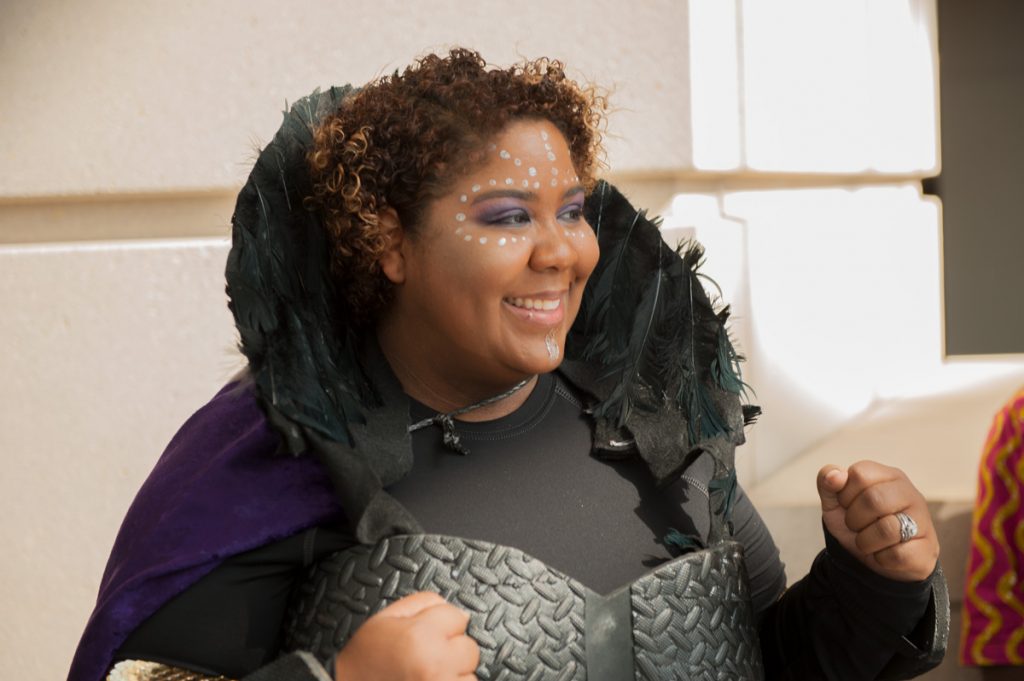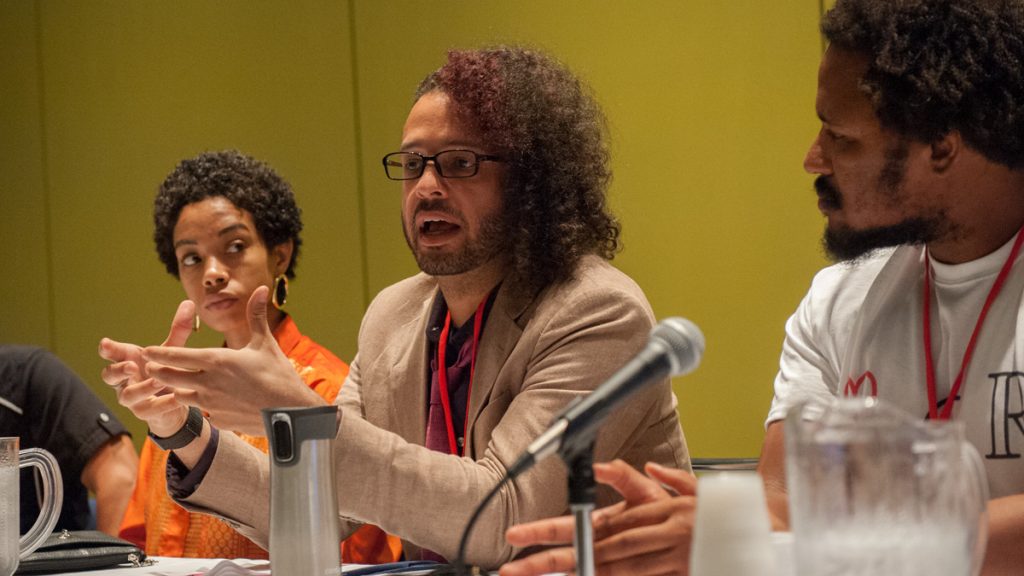In July, Fermilab joined Wakandacon in Chicago, the three-day Afro-futuristic celebration of the black experience, nerd culture and science. It was a perfect opportunity to present the public with a broader view of science and who can be a scientist.
Designed to be free from prejudice, Wakandacon included cosplay contests, videogame contests, panels on topics such as writing fan fiction as an African American girl, a variety of vendors and more. It embraced the themes of the Marvel blockbuster “Black Panther” and ran with them.
“Fermilab folds and jells very well with the Wakandacon mission,” said DanaSimone Stovall-Savage, an Aurora resident attending the event. “It is not just about Black Panther, but it’s about the things behind it — the technology, the innovation, the creativity, the opportunity to explore and to connect with other people and to learn more.”
At the event, members of the Fermilab community discussed the challenges of minorities working in science, promoted opportunities to engage with the lab, and shared scientific demonstrations — including liquid-nitrogen experiments and magnetic levitation. The diverse representatives of Fermilab encouraged attendees to contribute their skills and perspectives to the scientific community to build a more diverse, scientifically advanced future.

Fermilab intern Tiffany Price connects with DanaSimone Stovall-Savage at Fermilab’s booth. Photo: Bailey Bedford
Diverse voices in STEM
Embracing the event’s themes of diversity and advanced science, Mario Lucero, a diversity and inclusion specialist at Fermilab, moderated a panel of four other Fermilab scientists who are members of minority groups. The members recounted the obstacles that they experienced working in technical fields, how they came to find a place at Fermilab, and how they are working to improve Fermilab and the larger STEM community.
“It’s inspiring seeing so many black women and men in a field that historically has been underrepresented for us,” said Ayanna Jones, a chemistry doctoral student from the panel audience. “And for me it is inspiring because I think we all have similar stories and times where it got really hard.”
The speakers’ experiences included people assuming they were incompetent, accusing them of plagiarism without cause, speaking over them and making sexist, racist or microaggressive statements. The negative effects of these incidents and other aspects of their career were exacerbated by the lack of mentors to guide them in responding to the particular challenges they faced.
Fermilab scientist Jessica Esquivel shared how it felt to join Fermilab after being the second black woman to graduate from the Syracuse University physics doctoral program, where she often felt ostracized.
“It was a weight lifted off my shoulders. There was diversity,” Esquivel said. “And Fermilab as an institution really cares about equity, diversity and inclusion. And it wasn’t lip service. They value my input and value my work when it came to helping increase diversity in STEM.”
Panel members also provided advice to potential graduate students: When looking at a program, they said, keep in mind that the people you work with and whether they value you is more important than the exact physics project you work on.
“If you’re somewhere where you’re valued, you’ll learn to love the physics that you do,” said Katrina Miller, a University of Chicago graduate student who does research at Fermilab and member of the panel.
The panelists demonstrated that a scientist can be a woman, can be black, can be gay, or can be someone who enjoys making and wearing their own superhero costume. Esquivel proved a scientist can be all of the above. After the panel, she went on to win the veteran cosplayer competition with her handmade costume of Princess Shuri from “Black Panther.” In Esquivel’s take, Princess Shuri had become queen and took on the superhero mantle of the Black Panther. Esquivel incorporated her tech skills by including working lights in her costume.

Fermilab scientist Jessica Esquivel poses in her award-winning Black Panther cosplay. Photo: Bailey Bedford
Educating, entertaining, engaging
During Wakandacon, Fermilab representatives hosted a booth to promote the lab’s mission, discuss opportunities to visit or intern at Fermilab, and provide some hands-on opportunities to learn about science. Guests marveled as a magnet fell eerily slowly through a copper pipe and played with other demonstrations of intriguing science. The booth educated and delighted children and adults alike.
Fermilab’s most memorable displays came when engineer Jerry Zimmerman, known to locals as Mr. Freeze, put on cryogenics shows, demonstrating how the world can defy our expectations when pushed to extremely cold temperatures. He used liquid nitrogen — part of the air we breathe cooled to liquid form — to perform a variety of stunts, from freezing a rose and crushing it into dust to loudly blowing up a cardboard box to show the expansion caused by warming liquid nitrogen. His show also included a superconductor levitating on a magnetic track, reminiscent of the maglev trains featured in the climax of “Black Panther.”
“The Fermilab booth really does fit into the Wakanda theme because instantly it made me think of the scene where there was fighting and they had speed rail trains on magnetic rails, and Fermilab basically shows you how that works,” said Darryl Smith, a Wakandacon attendee. “I think it’s really cool.”
The booth was also an opportunity for Fermilab staff to invite the public to visit the lab, which is open to the public seven days a week. They encouraged young potential scientists to apply for internships so they could learn firsthand how they can make valuable contributions to scientific progress.
The booth helped at least one person who was not even at the event connect with Fermilab. During the event, Stovall-Savage was having a video chat with her daughter when her daughter spotted Fermilab’s signature shade of blue.
“I had my daughter on FaceTime,” Stovall-Savage said. “And she saw a little bit of the blue, and she was like, ‘Mom, is that Fermilab?” I said, ‘Yeah’. She said, ‘Go back, go back! See if they’ve got internships.’”
Her daughter ended up connecting with Tiffany Price, a current Fermilab intern who was staffing the booth. Stovall-Savage said she was glad for the opportunity for her and her daughter to speak with Fermilab interns and employees instead of just seeing the lab’s name and logo as an event partner.
A brighter future
Fermilab is constantly pushing for improvement — better technology, better understanding of our universe, better inclusion of the best minds. Wakandacon, promoted as a chance to ‘find your tribe,’ also embraced these principles and provided a space for Fermilab researchers to share their experiences and prove that no one should feel like they can’t be a scientist because of what they look like, what they sound like or what their background is.
“This event and similar ones, like the ones organized by the National Society of Black Physicists, are some of the rare events where scientists who are underrepresented in STEM actually have a chance to come together,” said Fermilab scientist Brian Nord, one of the lab panelists. “We don’t always have that chance because we’re so separated in different locations, where there aren’t critical masses of us in each of our institutions. And so these opportunities to get together and appreciate both our nerdness and our blackness are rare and special.”
To learn more about diversity and inclusion at Fermilab, visit diversity.fnal.gov.





